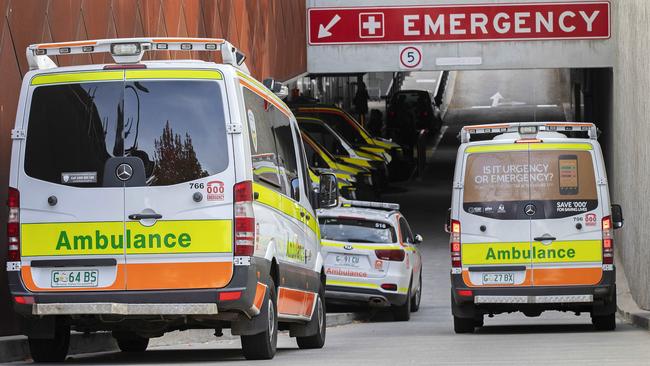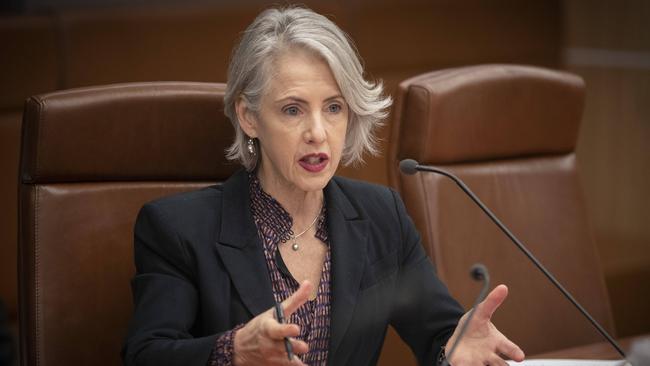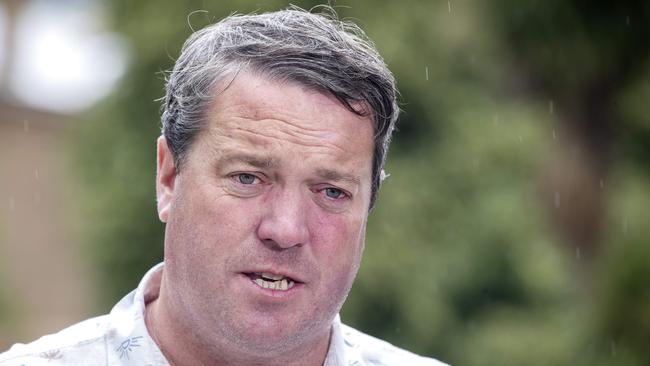Call for summit to address ambulance ramping, as statistics indicate deepening crisis
The Greens have hit out at the state government for “deliberately” giving out-of-date data showing the scale of Tasmania’s ambulance ramping problem. Their response >

Tasmania
Don't miss out on the headlines from Tasmania. Followed categories will be added to My News.
The Greens have accused the state government of deliberately misleading the public regarding the extent of ambulance ramping in the public hospital system, claiming data has been misrepresented in an attempt to minimise the scale of the problem.
The Sunday Tasmanian reported that more than 15,000 patients were ramped at hospitals across the state in the first nine months of the 2022-23 financial year alone and waited an average of two hours to be transferred from ambulance to hospital.
A government spokesperson cited data from the Australian Medical Association showing that almost 80 per cent of patients in Tasmania were transferred within 30 minutes.
But Greens health spokeswoman Rosalie Woodruff said this particular data was for 2020-21 and that the situation had worsened significantly since then.
“The information the Greens extracted from the government in [budget] estimates shows things have become so much worse since then, with a large drop to just 67.5 per cent of arrivals being transferred within 30 minutes,” she said.

“What the Liberals have done is deliberately provide out-of-date information to try and mislead Tasmanians, in a futile effort to defend their terrible record on ramping.”
Deputy Premier Michael Ferguson said there was currently “higher demand” for health care in the community and the government was employing more paramedics and opening additional beds in hospitals to try to bring down ramping rates resulting from the spike.
“Labor and the Greens were the ones who cut health and hospital funding. We’ve had to reverse all of those [cuts],” he said.
“But still the challenge is real and we, of course, have a growing population. So we’ll continue to provide the support that’s needed.”
15,000 patients: Call for crisis meeting as ramping hits breaking point
There are calls for the state government to convene an urgent summit to address the worsening ambulance ramping crisis, after newly released figures revealed more than 15,000 patients were left ramped outside hospitals in the first nine months of this financial year alone.
According to official Health Department statistics, nearly half (47.8 per cent) of all ambulances at the Royal Hobart Hospital (RHH) were ramped on arrival in 2022-23, up from 42.6 per cent in the previous year. The number has risen by a significant 17.1 per cent over the past five years.
At the Launceston General Hospital, the situation isn’t much better, with 43.1 per cent of all ambulances being ramped on arrival this financial year (+1.9 per cent on 2021-22). At Burnie’s North West Regional Hospital, the figure sits at 21.4 per cent and at the Mersey Community Hospital, it’s 13.6 per cent.
The data for 2022-23 was released to the Greens after the party’s health spokeswoman, Rosalie Woodruff, put a question on notice to Premier and Health Minister Jeremy Rockliff in budget estimates earlier this month.

Dr Woodruff said the numbers were “so disturbing” and that urgent action needed to be taken to fix the snowballing problem.
“This rapid, enormous increase of ramping is the terrible result of a decade where the Liberals have under-invested and refused to plan,” she said.
“The government has been warned for years about the rising demand for hospital care and ambulance services from our ageing and sicker population. Instead of planning for this predictable growth, and funding the resources to manage it, they’ve put their focus elsewhere.”
For the first time, statistics have been provided relating to the total number of patients ramped at each hospital.
A total of 15,686 patients were ramped in the first nine months of 2022-23, with 1743 ramped per month, at an average of two hours per patient. There were 9135 patients ramped at the RHH alone.
Ramping occurs when emergency departments reach capacity, forcing patients to wait in ambulances on the ramp outside the hospital, often depriving them of the full medical treatment they require.

There is a dedicated room at the RHH where ramped patients are able to be treated by paramedics, while at the LGH it’s more likely the patients would remain in the back of ambulances.
Health and Community Services Union (HACSU) assistant secretary Robbie Moore said the government should call an “urgent crisis meeting” to tackle the ramping issue head-on and highlighted a lack of beds and staff in the public hospital system as key factors causing the problem.
“We need a summit where it’s all put out there, all ideas are on the table, and it should be involving all parliamentarians, all parties, and all levels of government,” he said.
“Because this shouldn’t be happening in a developed wealthy country like Australia.”
Mr Moore said ambulances were not the appropriate setting for comprehensive medical care.
“We’ve seen people die on the ramp,” he said. “And the inaction by the government, they’re putting lives at risk and people will die while this situation continues.”
A government spokeswoman said emergency departments were seeing “increased pressure” as a result of greater numbers of people presenting to hospital who could not get in to see a GP.
“This is impacting on ambulance transfers, but recent AMA data shows almost 80 per cent of patients in Tasmania were transferred from ambulance to hospital within 30 minutes – one of the highest rates in Australia,” she said.

“Hospitals are continuing to implement new initiatives to deal with the challenge including our Statewide Access and Patient Flow Program, and alternate models of care such as our Secondary Triage, Community Paramedics and PACER program that offer care without the need of an ambulance.”
The spokeswoman said if the Commonwealth government was to boost GP numbers, it would “make a real difference”.
A Health Department spokesman said the government had “ongoing engagement” with HACSU regarding “transfer of care delays” and demand for ambulances.
“The department has consulted with HACSU on a range of measures to address these issues,” he said.
“An example is the rostering of paramedics at the Royal Hobart Hospital since July 2022 to assume care of patients awaiting transfer of care, to enable the release of paramedics to respond to other cases in the community.”
A study released by Ambulance Victoria last year found that delays in offloading patients were associated with about 70 preventable deaths in the state in 2018.
RAMPING STATS:
Percentage of ambulance arrivals ramped by hospital (2017-18 - 2022-23):
Royal Hobart Hospital (RHH):
2017-18: 30.7 per cent
2018-19: 33.7 per cent
2019-20: 31.2 per cent
2020-21: 33.4 per cent
2021-22: 42.6 per cent
2022-23: 47.8 per cent
Launceston General Hospital (LGH):
2017-18: 21.1 per cent
2018-19: 24.9 per cent
2019-20: 31.4 per cent
2020-21: 38.6 per cent
2021-22: 41.2 per cent
2022-23: 43.1 per cent
North West Regional Hospital (NWRH):
2017-18: 7 per cent
2018-19: 5.4 per cent
2019-20: 9.6 per cent
2020-21: 22.5 per cent
2021-22: 21.5 per cent
2022-23: 21.4 per cent
Mersey Community Hospital (MCH):
2017-18: 8.2 per cent
2018-19: 7.4 per cent
2019-20: 7.3 per cent
2020-21: 41.9 per cent
2021-22: 14.2 per cent
2022-23: 13.6 per cent
Total Patients Ramped (first nine months of 2022-23):
RHH:
9,135
LGH:
4753
NWRH:
1308
MCH:
490
TOTAL: 15,686
Average hours ramped per patient (by hospital):
RHH:
2 hours
LGH:
2 hours, 40 minutes
NWRH:
38 minutes
MCH:
34 minutes
STATEWIDE AVERAGE: 2 hours
More Coverage
Originally published as Call for summit to address ambulance ramping, as statistics indicate deepening crisis





